Features Available Online
And Then the Rains Came
When a large-scale rain event impacts soils on a 190-acre construction site, a fast and well-managed response provides a model for future dewatering management.
by George Hild
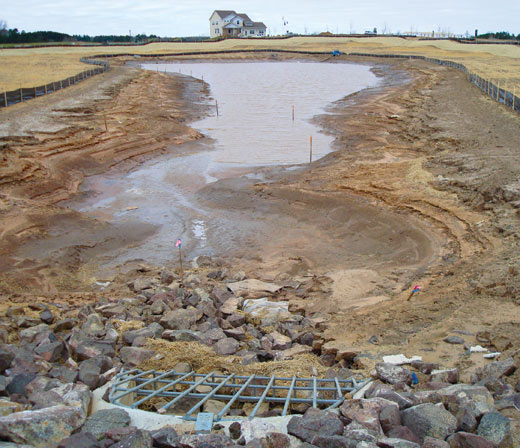
One of several on-site large capacity retention basins following successful drawdown and filtration in preparation for additional rains and spring snowmelt.
“IT was a dark and stormy night,” originally penned by Victorian novelist Edward Bulwer-Lytton, served as the opening phrase of his 1830 novel Paul Clifford. One hundred and seventy-eight years later, variations of those words are still commonly used to describe what we now refer to as “rain events”.
When I was growing up in Iowa, major rainfalls were always an irresistible invitation to kick off your shoes, grab your yellow hooded raincoat, and hit the gutters while the water swirled around your kneecaps. Needless to say, I now look at these events from an environmental impact point of view, even though part of me still longs to relive those memories without thinking about the TMDL (total maximum daily loading) results. That amount of rainwater, other than still producing some serious fun for kids, now produces serious problems for those of us who have chosen to make erosion and sediment control a part of our professional lives.
| One of these sites in particular, a large-scale housing development, was destined to become one of the largest, if not the largest, successful storm water dewatering projects in the state of Minnesota. This example of teamwork and innovation provides a model of rain event response. |
Extreme weather conditions will always introduce unforeseen challenges. If a sudden rain event finds you with exposed soils on your site, as it did with a large number of construction projects in Minnesota, the game is on. One of these sites in particular, a large-scale housing development, was destined to become one of the largest, if not the largest, successful storm water dewatering projects in the state of Minnesota. This example of teamwork and innovation provides a model of rain event response, and describes the effects that record-setting rainfalls have on people, the resources, and the BMPs (best management practices) that we currently employ.
During the summer of 2007, a powerful and persistent drought affected the Minneapolis-St. Paul metropolitan area as well as much of the state of Minnesota. As field crops withered and lake and river levels dropped to historic lows, construction plans and activities continued. Everyone tended to their daily business while keeping an eye on the sky, hoping nature’s pattern would eventually favor the region with some much needed precipitation.

Rain for Rent water treatment system including Biostar chitosan injection, three 22,000 gallon settling tanks, pumps, a sand filter unit, and a final polishing unit.
I am sure that all of you are familiar with another famous phrase, “Be careful what you wish for, it just might come true.” It happened without me even washing my truck. In August 2007, the other shoe abruptly dropped with a resounding and unmistakable thud.
The notoriously parched conditions that lasted from May through July suddenly did a military-style about-face, darkening the sky and producing a record-setting rainfall amount. The Twin Cities Area recorded close to 20 inches of water from August through October. The good news was that lake and river levels were rising, soil moisture was being replenished, and plants, seeds, and crops were once again receiving thirst-quenching moisture, although a little too much and a little too late in some cases. The bad news was that you generally don’t receive 20 inches of rain in a short span of time in the form of a nice soft shower. It pours! Parts of the state, especially the southeastern areas, were impacted on a devastating level, resulting in millions of dollars in related damages.
Erosion and sediment control is relatively easy as long as it doesn’t rain. It is a little different from preparing a fortress for an attack. If the attack doesn’t come, or it is light and easily repelled, life is good. However, increase the intensity of the attack to the point where breaching occurs, and you have a problem. At that point, teamwork and communication between construction site managers, subcontractors, material suppliers, and inspectors becomes critical. Without this communication, weather-related situations can rapidly spin out of control resulting in frustrations, additional failures, and in some cases, monetary fines.
During construction operations, generally soil is stripped, moved, and stockpiled somewhere on-site for future use. It is at this point during most operations that unprotected soil is in its most vulnerable condition. I would encourage you to consider the challenges of soil protection and sediment control related to a small one-acre construction site. Now imagine those same challenges but on a 190- acre site bordered by a trout stream on one side and a previously listed impaired wetland on the other. Now throw in the record-setting moisture, and “welcome to a long-term rain event”.
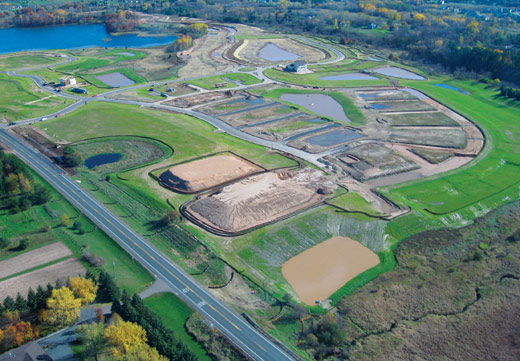
Aerial perspective showing the general site conditions as well as the storm water retention capacities. Photo credit: Washington County Conservation District.
In such a situation, normal everyday construction meetings quickly take on a new sense of urgency and transition into strategic planning sessions. In addition to the record rainfalls, dewatering the site had to address issues of rising and overcapacity in five large holding ponds and two infiltration basins, circulating and retaining storm water on-site, repairing and reinforcing existing BMPs, ongoing site prep work for final stabilization, and the creation and implementation of effective dewatering methods. All had to take place under the guidance and jurisdiction interest of six separate state and local agencies, each with a common interest in the construction and weather-related activities. These included the City of Stillwater, the Minnesota Department of Natural Resources, the Minnesota Pollution Control Agency, the Brown’s Creek Watershed District, the Carnelian Marine St.Croix Watershed District, and Washington Conservation District. Communication, cooperation, and teamwork were needed and needed fast. The construction site manager, along with their team of subcontractors and support staff, stepped up to the plate. They were determined to get the job done and get the job done right.
First, the rainfalls had not only succeeded in driving on-site water retention to capacity, but had also created saturated soil conditions that both limited the time and impaired the ability to perform timely site repairs without disturbing previously established and protected wetland areas. The construction site found itself in need of unplanned, expensive, and time-consuming restabilization efforts. The on-site erosion control contractor, Total Repair of St. Paul, Minnesota, responded to their new “on call” 24-hours-per-day, seven-days-a-week status, operating the pumping and filtration equipment, continuing to accommodate the ever-changing backlog of repair work, and all while completing the daily demands of what would be considered their “normal” work schedule.
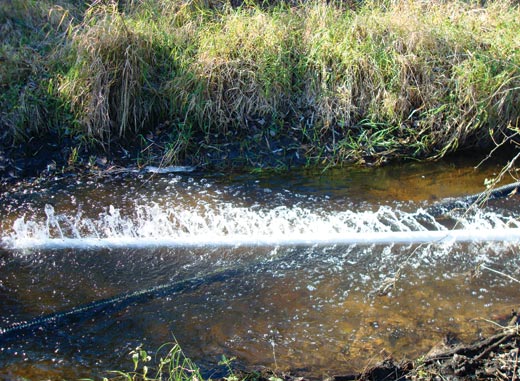
A low impact, post-treatment, anti-scour water discharge method into adjacent creek utilizing perforated PVC pipe.
As mentioned, the site contained seven holding ponds with a 0-HWL (high water level) total volume capacity of 30.23 acre feet, a 9,851,912 HWL in gallons, with a 0-NWL (normal water level) of 4,758,071 gallons. Following the rains, most of the on-site ponds were near the HWL capacity levels. Obviously, the existing water levels needed to be drawn down to acceptable levels to accommodate the potential for additional rainfall and to prepare for the winter freeze-up and spring snowmelt.
Successfully capturing and retaining storm water on site is one thing, but now that you have it, what are you supposed to do with it? It’s dirty! Some NTU (nephelometric turbidity units) readings, which indicate how dirty the water is by measuring how much light is scattered by the suspended particles in the water, were in excess of 800 NTUs. To put that number in perspective, the NTU measurement of drinking water is normally under 10. The storm water contained fine suspended clay particles that measured less than 40 microns in size. Considering the fact that a piece of human hair measures approximately 70 microns in diameter, these particles are extremely small. Because of their size and the fact that they are all negatively charged, clay particles generally remain suspended in water and won’t settle out on their own.
Holding this volume of storm water on-site required the use and insertion of air-inflated ball plugs in the outlet lines to effectively block the discharge of sediment-laden water into the surrounding surface waters. Weir structures and water flow discharge routes were effectively sealed off to prevent accidental discharge which would have resulted in serious violations, fines, and work progress interruptions, not to mention the related negative environmental impact to the surface water bodies adjacent to the construction site.
Since two of the seven holding ponds had been designed and constructed for infiltration, it was decided that the storm water being held in the remaining ponds could and would be pumped into those basins. The infiltration rate, as per the site engineer’s calculations, was expected to be 20,000 to 40,000 gallons per day depending on the existing water levels. The sheer volume of water to be transferred required numerous pumps and several thousand feet of overland hose. This method proved too slow to effectively move and manage the water, and the added volume overwhelmed the infiltration rate and design abilities of the two basins. And since it was already October, the changing climate limited the time available for the dewatering process. Due to the time constraints, it was decided that the water would need to be treated and filtered in order to meet the NTU requirements for discharge directly into the adjacent stream. Local agency personnel determined that the water could not be released from the site without an NTU level at or below 10. An NTU reading was required hourly to ensure discharge did not exceed that preset limit.
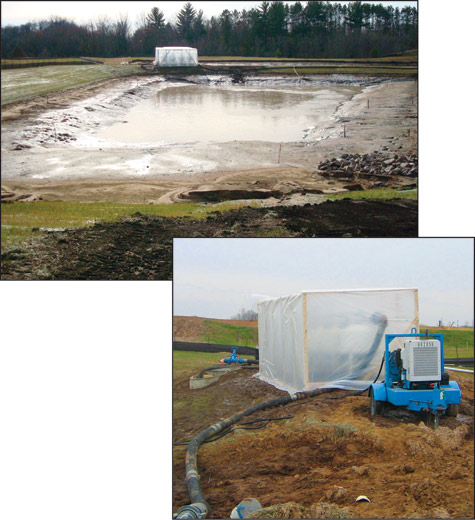
Late season subfreezing temperatures required temporary heated protection of the sand filtration unit. This enabled the dewatering of the final basin (top photo).
The challenge was to maximize efficiency while effectively treating the storm water, enabling compliance within the NPDES phase II and with local agency discharge requirements. Numerous methods, techniques, and products exist that are designed to provide the necessary tools to assist in dealing with issues relating to storm water treatment and management. A construction site management team must consider not only the costs of implementing and operating the selected method, but also the project’s time frame and environmental constraints.
To be successful, dewatering activities needed to be accomplished by freeze-up, while consistently adhering to all federal, state, and local discharge requirements. In addition, the sheer volume of water to be treated, the water’s high turbidity or NTU level, and the time constraints placed by the impending cold weather all justified the decision to select and utilize specialized treatment equipment. This equipment would be set up and placed on-site, to enable the advancement of dewatering activities.
The Rain-for-Rent Company supplied a large capacity, skid mounted, four-pod sand filtration unit in combination with settling/storage tanks and pumping equipment, providing the on-site management team with the best opportunity to accomplish all discharge goals within the timeframe allowed. The filtration equipment was placed in a central location on the construction site in close proximity to one of the two infiltration basins. Storm water currently contained on-site was pumped to this basin from the second infiltration basin and the remaining ponds. This strategic equipment location also served to minimize the discharge distance from the sand filter unit to the stream.
The treatment and sand filtration system also required and employed several additional Rain-for-Rent components that contributed to the success of the dewatering project. In an effort to immediately address and treat the highest risk of overflow, the submersible pump was soon replaced by a floating pedestal pump which did not stir up additional sediment. The water was pumped through a four-inch hose for approximately 100 feet, at which point the water was injected with Biostar chitosan at a predetermined dose rate to effectively flocculate the fine suspended particles into larger particles or flocs. The Biostar chitosan was injected into the flow from a 275-gallon tote of liquid using a metered injection pump which ensured accurate dosing for maximum treatment of the storm water.
The water then proceeded through another 50-75 feet of hose to allow for time for the Biostar chitosan to mix properly, before entering one of three 21,000-gallon temporary storage tanks. These three tanks allowed for pre-settling of the sediment particles prior to the water being pumped through 600 feet of six-inch HDTP pipe to the sand filter unit.
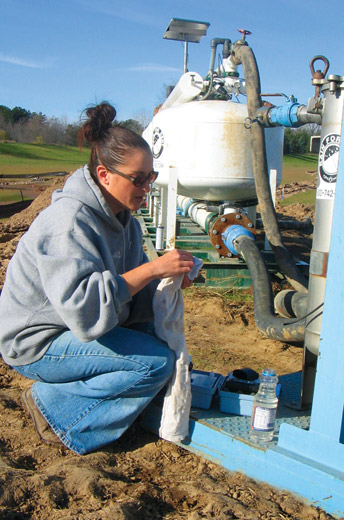
The development manager conducted hourly NTU discharge readings for record keeping and compliance.
The water being pumped from the supply pond was measuring 400-800 NTUs. But immediately after the water passed through the treatment system into the holding tanks, the sediment flocs (larger sediment particles) began to settle to the bottom of the storage tanks, resulting in an NTU reading of less than 25 within 15-30 minutes. That water was then pumped out of the storage tanks to the sand filter unit. The unit was positioned so the automatic backwash sequence would deposit filtered sediment back on-site and not be discharged.
The treated water was then pumped from the sand filter unit to the creek or discharge point through 450 feet of four-inch PVC manufactured pipe at a rate of approximately 200-300 gallons per minute. So as not to scour the creek bed at the discharge point, the PVC pipe was drilled with a series of exit holes to allow for a no-impact energy dissipation fountain effect dispersal system. As required, NTU readings were taken hourly at six different locations throughout the site and along the filtration line, then submitted and recorded in compliance with inspector and requiring agency guidelines. Those readings ranged from 3-9 NTUs consistently.
As the pumping operations continued into November, the project’s constraints now included plummeting nighttime temperatures and reduced daylight hours. October 27th marked the first sub-freezing night of the fall season. Pumping had to be reduced from 24 hours per day to 10-12 hours per day, seven days a week.
Temporary wood frame and poly shelters were constructed to cover, protect, and heat the sand filter unit and the 275-gallon Biostar chitosan tote. Even with those precautions, late-season mornings often necessitated a few extra hours of thaw time on exposed components prior to beginning the pumping operations.
The pumping and filtration activities resulted in the successful drawdown and treatment of the storm water volume contained in the five holding ponds from 7.3 million gallons to 1,606,445. The two infiltration basins enabled the infiltration of close to 1.2 million gallons of water over the course of the dewatering activities. Approximately 4 million gallons of water were treated and moved offsite during the roughly 30 days of pumping time averaging about 125,000-150,000 gallons per day.
As discharge requirements have become tighter and more restrictive, the need for reliable and affordable methods and products becomes vital. This tighter and more restrictive environment should not be viewed as a deterrent, a distraction, or an insurmountable obstacle to success and compliance. On the contrary, this mandated environment has lead to the introduction of more efficient and reliable methods for storm water management.
This project proved to be a valuable learning experience for everyone who was directly and indirectly involved. The success heightened awareness among the construction industry as to the effectiveness of these dewatering and filtration methods. I want to emphasize the importance of teamwork, cooperation, and communication, which all contributed to and played important roles in ensuring the success of this project.
I personally would like to acknowledge the dedication and efforts of Mark and Jeff Trog from Total Repair Erosion Control, Hendryk Sowa of Rain-for-Rent, and Paula Guetter of Emmons & Olivier Resources, for their dedication and commitment to the erosion and sediment control industry and to the protection of our natural resources, for making this challenge rewarding and successful.![]()
For more information contact George Hild, Hild & Associates, Inc, 326 South Glover Road, River Falls, WI 54022, (715)426-5131, fax (715)426-9887, ghild@hildandassociates.com or visit www.hildandassociates.com.

